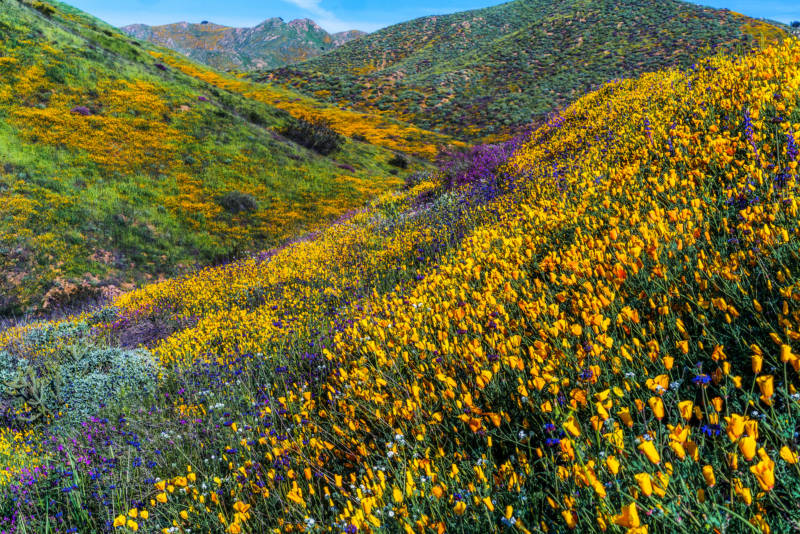If you’re in the Bay Area, you might have noticed that trees have been splendidly in bloom around the region since early February. Vibrant wildflowers are popping up around California, a sight of bursting color that many look forward to every year — as much as they look forward to striking-looking invasive species that carpet the hillsides.
Spring is in the air in a big way, thanks to the abundant rain we’ve received so far. So you might be wondering: Will there be a “super bloom” this year? Where are the best places to see wildflower blooms in the Bay Area? And what’s the science behind the seasonality of plant blooms?
What are super blooms, and can we see them in the Bay Area?
Unfortunately, we might not be seeing a super bloom in California like the one we saw in 2005 or the colorful explosion of 2019. But that’s not necessarily bad news.
“That doesn’t mean that we’re not having some amazing blooms this year. But at least in the desert, we’re not getting the super bloom that we’ve had in the past,” said Cameron Barrows, conservation ecologist at the Center for Conservation Biology at UC Riverside.
California is the most biologically diverse state in the country, home to about 8,000 species of plants. Over 2,300 of those are wildflowers, according to Barrows.
A super bloom, he says, is not a scientific term, and is mainly used by the media to describe incredible bloom events that are not very common, when many different species of wildflowers bloom at the same time. “There might be anywhere that’s 50 to 100 different species in bloom during a super bloom event,” Barrows said.
The right amount of rain and temperature set the stage for a super bloom. “I refer to this as sort of a global ‘Goldilocks scenario’ where [it’s] not too much rain, not too little rain — not too hot, not too cold,” said Barrow. “When it is just right, then lots and lots of species will bloom at the same time.”
The best blooms happen when we have a wet year followed by a strong drought, according to Richard Minnich, professor at the Department of Earth and Planetary Sciences at UC Riverside. He says that the drought suppresses invasive species or annual grasses, leaving room for the wildflowers to take off.
Minnich cites the super bloom event of 2005 in Death Valley as a great example of this, “after one of the wettest winters we would ever see, and it also followed some dry weather.”
 A Walker Canyon super bloom in Lake Elsinore in 2017. (Beau Rogers/Flickr)
A Walker Canyon super bloom in Lake Elsinore in 2017. (Beau Rogers/Flickr)
So why no super bloom already this year?
We’ve had exceptional rainfall so far in 2023, occurring earlier than in previous years. This encourages invasive plants to germinate earlier, taking over the opportunity for native wildflowers to bloom. And ideally, for a super bloom to occur, we’d need that “Goldilocks” balance to ensure that invasive plants don’t dominate and the native plants can “complete their entire life cycle,” Barrows said.
We’ve also had exceptionally cold weather these past few months, extending the bloom period to later in the spring, says Minnich.
“[Wildflowers] will also bloom later into the spring. Once they start they’ll last longer because the ground is obviously really wet,” he said.
Where and when can you see blooms in the Bay Area?
If you’re planning to head out on a trail to enjoy these wildflower blooms, be sure to respect the landscape and stay on designated trails. Do not trample or pick any flowers, and pack out anything you pack in.
Be aware that “there’s this entire ecosystem that the flowers are helping to support,” urged Barrows. He says that when you damage the wildflowers, “you are then not only impacting the bees and the butterflies and the hummingbirds and the animals that eat the flowers and eat the seeds and so forth,” but also the opportunity for future super blooms.
You might be able to spot wildflowers or colorful invasive plants in the locations mentioned in the 2019 KQED guide “Where to See a ‘Super Bloom’ in the Bay Area.” Places like Point Reyes National Seashore, the Berkeley Hills, Mount Davidson and Russian Ridge Preserve are some of the locations recommended.
If you’re in San Francisco, The San Francisco Standard recommends Balboa Natural Area, Bernal Hill, Corona Heights, Grandview Park, Tank Hill and John McLaren Park.



















